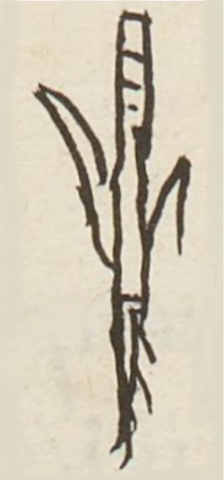Acamitl (MH493r)
This black-line drawing of the compound glyph for the personal name Acamitl consists of two elements that are fused, a reed (acatl) and an arrow (mitl), to speak of a Reed-Arrow. One can see the arrow, with is point facing downward, but the arrow also has a long leaf coming off each side, reminding the reader that the arrow was made from a plant.
Stephanie Wood
Most arrows (mitl) were made from the acatl plant, so Acamitl is somewhat redundant, emphasizing the source of the arrow. For comparison, see the acatl from the Codex Mendoza (below) that is also both the plant and the arrow, drawn and painted even more clearly. Arrows were used in hunting and in warfare. The bow and the arrow came into central Mexico with the southern migration from northern regions characterized by semi-sedentary peoples, such as the Chichimecas.
Stephanie Wood
parthasal acamitl
Baltazar Acamitl
Stephanie Wood
1560
José Aguayo-Barragán and Stephanie Wood
reeds, cañas, carrizo, arrows, flechas

aca(tl), reed, https://nahuatl.wired-humanities.org/content/acatl
mi(tl), arrow or dart, https://nahuatl.wired-humanities.org/content/mitl
La Flecha de Carrizo
Stephanie Wood
Matrícula de Huexotzinco, folio 493r, World Digital Library. https://www.loc.gov/resource/gdcwdl.wdl_15282/?sp=65&st=image
This manuscript is hosted by the Library of Congress and the World Digital Library; used here with the Creative Commons, “Attribution-NonCommercial-ShareAlike 3.0 License” (CC-BY-NC-SAq 3.0).





